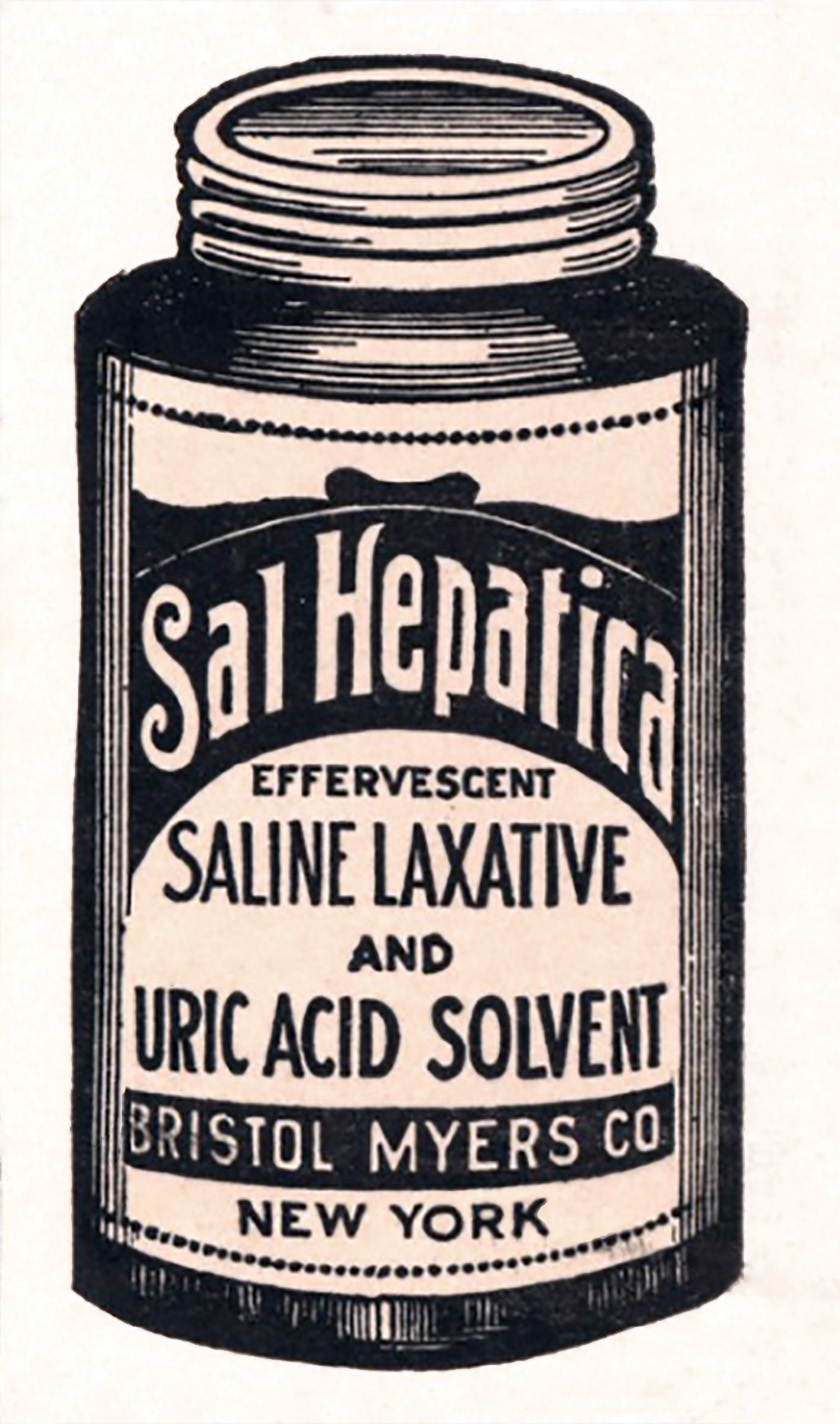Sal Hepatica on:
[Wikipedia]
[Google]
[Amazon]
 Sal Hepatica is the name of a mineral salt
Sal Hepatica is the name of a mineral salt
Collection of mid-twentieth century advertising featuring Sal Heptica from the TJS Labs Gallery of Graphic Design.
*https://www.flickr.com/photos/internetarchivebookimages/14598496190/ book scan of a bottle of Sal Hepatica from 1889 *http://www.old-time.com/commercials/1930%27s/Smile.html co-marketing of Ipana and Sal hepatica in the 1930s Laxatives
 Sal Hepatica is the name of a mineral salt
Sal Hepatica is the name of a mineral salt laxative
Laxatives, purgatives, or aperients are substances that loosen stools and increase bowel movements. They are used to treat and prevent constipation.
Laxatives vary as to how they work and the side effects they may have. Certain stimulant, lub ...
that was produced and marketed by Bristol-Myers
The Bristol Myers Squibb Company (BMS) is an American multinational pharmaceutical company. Headquartered in New York City, BMS is one of the world's largest pharmaceutical companies and consistently ranks on the ''Fortune'' 500 list of the lar ...
from its inception in 1887, becoming its first nationally recognized product in 1903, until 1958. When dissolved in water, it was said to reproduce the taste and effect of the natural mineral water
Mineral water is water from a mineral spring that contains various minerals, such as salts and sulfur compounds. Mineral water may usually be still or sparkling (carbonated/effervescent) according to the presence or absence of added gases.
T ...
s of Bohemia.
Composition and mechanism of action
The product was composed of Glauber's salt (sodium sulfate
Sodium sulfate (also known as sodium sulphate or sulfate of soda) is the inorganic compound with formula Na2SO4 as well as several related hydrates. All forms are white solids that are highly soluble in water. With an annual production of 6 mill ...
), baking soda ( sodium bicarbonate), tartaric acid
Tartaric acid is a white, crystalline organic acid that occurs naturally in many fruits, most notably in grapes, but also in bananas, tamarinds, and citrus. Its salt
Salt is a mineral composed primarily of sodium chloride (NaCl), a c ...
, common salt (sodium chloride
Sodium chloride , commonly known as salt (although sea salt also contains other chemical salts), is an ionic compound with the chemical formula NaCl, representing a 1:1 ratio of sodium and chloride ions. With molar masses of 22.99 and 35 ...
), sodium phosphate
Sodium phosphate is a generic term for a variety of salts of sodium (Na+) and phosphate (PO43−). Phosphate also forms families or condensed anions including di-, tri-, tetra-, and polyphosphates. Most of these salts are known in both anhyd ...
and traces of lithium carbonate
Lithium carbonate is an inorganic compound, the lithium salt of carbonate with the formula . This white salt is widely used in the processing of metal oxides. It is listed on the World Health Organization's List of Essential Medicines because it ...
and water. It was marketed as a saline laxative and alkalinizing agent. In the latter role it was recommended for dissolving uric acid
Uric acid is a heterocyclic compound of carbon, nitrogen, oxygen, and hydrogen with the formula C5H4N4O3. It forms ions and salts known as urates and acid urates, such as ammonium acid urate. Uric acid is a product of the metabolic breakdown ...
in gout
Gout ( ) is a form of inflammatory arthritis characterized by recurrent attacks of a red, tender, hot and swollen joint, caused by deposition of monosodium urate monohydrate crystals. Pain typically comes on rapidly, reaching maximal intens ...
and "rheumatism
Rheumatism or rheumatic disorders are conditions causing chronic, often intermittent pain affecting the joints or connective tissue. Rheumatism does not designate any specific disorder, but covers at least 200 different conditions, including ar ...
", and for various other stomach, liver, and kidney disorders.
See also
* Epsom Salt AMagnesium sulfate
Magnesium sulfate or magnesium sulphate (in English-speaking countries other than the US) is a chemical compound, a salt with the formula , consisting of magnesium cations (20.19% by mass) and sulfate anions . It is a white crystalline solid, ...
salt marketed as the active ingredient in the water from Epsom
Epsom is the principal town of the Borough of Epsom and Ewell in Surrey, England, about south of central London. The town is first recorded as ''Ebesham'' in the 10th century and its name probably derives from that of a Saxon landowner. ...
References
{{reflistExternal links
Collection of mid-twentieth century advertising featuring Sal Heptica from the TJS Labs Gallery of Graphic Design.
*https://www.flickr.com/photos/internetarchivebookimages/14598496190/ book scan of a bottle of Sal Hepatica from 1889 *http://www.old-time.com/commercials/1930%27s/Smile.html co-marketing of Ipana and Sal hepatica in the 1930s Laxatives